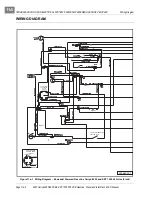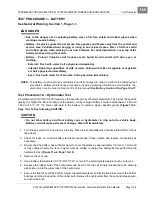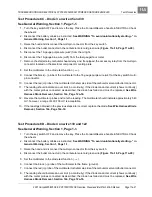
TROUBLESHOOTING AND ELECTRICAL SYSTEM: KAWASAKI POWERED GASOLINE VEHICLES
Test Procedures
2007 Carryall 295/295 SE & XRT 1550/1550 SE Gasoline, Diesel and IntelliTach M & S Manual
Page 11a-11
11A
Test Procedure 1B – Voltage Test
1. Turn the key switch OFF and remove the key. Place the Forward/Reverse handle in NEUTRAL. Chock
the wheels.
2. Check for loose or corroded battery terminal connections. Clean, tighten and replace connections as
necessary.
3. Set the multimeter to the 20 VDC setting.
4. Measure the voltage across the battery terminals. If the reading is less than 12.4 volts, or if the lowest
specific gravity reading from the hydrometer test is less than 1.225, recharge the battery. If battery volt-
age is greater than 12.4 volts and specific gravity is greater than 1.225, the problem is not with the bat-
tery. If the battery does not reach 12.4 volts, or if the specific gravity of a cell is still less than 1.225 after
charging, replace the battery.
See following NOTE.
NOTE:
A fully charged battery that is in good condition should have a specific gravity of at least 1.225 in
all cells and the difference in the specific gravity of any two cells should be less than 50 points.
Open-circuit voltage, the battery voltage with no electrical load, should be at least 12.4 volts.
Test Procedure 1C – Load Test
NOTE:
Ensure that the battery is fully charged before performing the following test procedure.
1. Turn the key switch OFF and remove the key. Place the Forward/Reverse handle in NEUTRAL. Chock
the wheels.
2. Check for loose or corroded battery terminal connections. Clean, tighten and replace connections as
necessary.
3. Connect a 160-ampere load tester to the battery posts.
See following NOTE.
NOTE:
If a load tester is not available, a load can be placed on the battery by removing the spark plug
wires and activating the starter motor. If this method is used, the voltage must be read when the
starter motor is turning.
See following CAUTION.
CAUT ION
• Activating the starter for more than a few seconds could result in damage to the starter motor,
the starter, and/or the flywheel gears.
4. Turn the load tester switch to the ON position.
5. Read the battery voltage after the load tester has been turned ON for 15 seconds. The minimum accept-
able battery voltage for proper engine starting is approximately 9.6 VDC.
6. If the battery voltage is acceptable, or if the electrical problem continues after the battery has been
replaced, test the electrical circuits.
7. If the voltage reading exceeds 9.6 volts at 70 °F (21 °C) (electrolyte temperature), check the starter.
See
the Kawasaki FH680D engine manual (CCI P/N 103351201). See also the following NOTE.
NOTE:
Record the voltage reading at 70 °F (21 °C). At lower electrolyte temperatures, the voltage reading
will be lower.
8. If the reading is less than 9.6 volts at 70 °F (21 °C) (electrolyte temperature), check the battery electrolyte
in each cell.
See Test Procedure 1A – Hydrometer Test on page 11a-9.
Summary of Contents for IntelliTach XRT 1550
Page 2: ......
Page 22: ...1...
Page 54: ...4...
Page 60: ...5...
Page 90: ...6...
Page 114: ...8...
Page 118: ...9...
Page 196: ...11A...
Page 290: ...11C...
Page 468: ...13C...
Page 490: ...14...
Page 498: ...15...
Page 548: ...16...
Page 560: ...Club Car R NOTES...
Page 561: ...Club Car R NOTES...
Page 562: ...Club Car R NOTES...
Page 563: ......

































